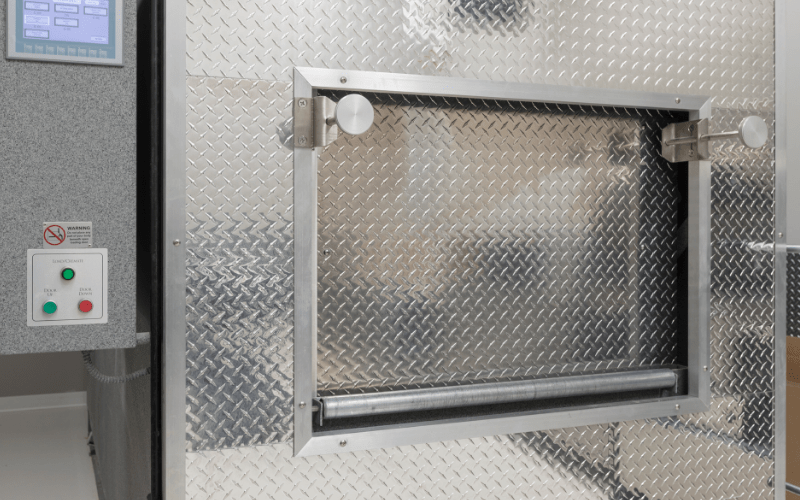Bare offers a simple and affordable cremation without compromising on the level of service. Click here to see the price for your area.
Cremation has overtaken burials as the preferred funeral method for Australians, but have you wondered what happens at a cremation and what is involved?
This article simplifies the cremation process and answers some common questions, like how is a body prepared for cremation and how can families be sure they receive the right ashes?
How is the body prepared for cremation?
After the funeral or viewing (if one is held), the coffin and body are respectfully transferred to the crematorium by the funeral provider. For a direct cremation with no service, the transfer occurs from the holding mortuary or care facility once all required documentation is complete.
Before cremation can take place, the death must be formally certified and the necessary permits or authorisations obtained. These legal approvals are required across Australia and are usually issued by a medical practitioner or authorised official, depending on the state or territory
To prepare the body, any items that could interfere with the cremation process, such as pacemakers, are removed. Jewellery, rings, and watches are also carefully taken off, documented, and either returned to the family or, if requested, left with their loved one to be cremated.
The deceased is then placed in a coffin or casket, which remains sealed for the cremation process. Australian regulations generally require the body to be placed in an approved container, such as a coffin, casket, or cremation capsule. For example, in New South Wales, the Public Health Regulation 2022 specifies that all cremations, including direct cremations, must use a coffin. These rules ensure the body is handled safely and respectfully at every stage of the process.
Can people with pacemakers be cremated?
Yes, people with pacemakers or prosthetics can be cremated. It is important to notify the funeral provider if the deceased has a pacemaker or any other medical device so that they can advise the crematorium.
Pacemakers and any other mechanical devices with batteries must be removed before the cremation can take place, as they contain combustible chemicals that could explode when exposed to extreme heat. In general, metallic implants such as pins, screws, and joints can remain in the body during cremation. These items are typically made of materials that can withstand the high temperatures of the cremation process without causing harm. However, it is always best to inform the funeral director beforehand regarding such implants.
After the cremation, any remaining metal implants or prosthetic materials are collected and sent for responsible recycling, often through specialist programs. These materials may be repurposed for industrial use or donated to charitable causes, depending on the crematorium’s policy.
Are organs removed before the cremation process?
Generally, there is no need for a deceased person’s organs to be removed before cremation, unless they are being used for organ donation.
Your loved one may have already registered as an organ donor, or the family or next of kin may be asked for permission to use the deceased person’s organs for eligible organ transplant patients. The next of kin must give their consent before any organ donation procedure can happen, however this is a decision you may need to make immediately after the person has died.
You can find out more about organ and body donation in this article.

How can I ensure I receive the right ashes?
The cremator will only allow for one standard-sized coffin to fit inside, so only a single cremation can ever take place at any one time.
When the cremation process is ready to begin, the coffin’s nameplate is checked with the cremation order to ensure the correct identity of the deceased person.
The coffin and ashes receptacle are clearly labelled, checked, and verified. Your loved one’s paperwork travels with them throughout their care journey, and we oversee each step to ensure continuous identification and respectful care.
How is a body cremated?
Before the cremation can take place, any metal parts attached to the coffin, like handles, are removed. The cremator is heated to a temperature between 800-1000 degrees.
The coffin is then inserted into a cremation chamber – with the deceased placed feet-first. A cremation chamber is an industrial furnace lined with fire-resistant bricks. It is the heat from the bricks that causes the cremation to occur.
Once the body and coffin have been completely cremated, the ashes remain. Any metallic contents like coffin nails are removed and the ashes are left to cool.
Once cool, any larger particles are ground into a fine, sand-like consistency. This is why cremated remains are commonly called ‘ashes’. They are then placed into a cooling tray. Once cool, the ashes are added to a sealed container or an urn, ready for collection or delivery.
How long does a cremation take?
It generally takes around two hours for an adult body to be cremated, with the entire process - including preparation and cooling – usually taking about three hours in total.
However, how long a cremation takes can vary depending on a number of factors including the deceased person’s body mass, bone density and the type of coffin being cremated. The time of day can also influence the process, as the first cremation of the day may take longer while the chamber reaches full temperature.
Older or less efficient cremator units may also take longer than newer, computer-assisted systems.

What can you put in a coffin for cremation?
Sometimes families may wish to place an item of sentimental value in their loved one’s coffin, like flowers, soft toys or written notes and cards. Similarly, families often request that their loved one is dressed in a special outfit for the cremation. Those things are generally safe to do.
Almost anything can be placed in a coffin for cremation, except glass or a battery-operated device – like a phone, radio, or pacemaker (as mentioned earlier).
If an item of jewellery is sentimental or valuable, it’s better to keep it or give it to a loved one who will appreciate it. Any jewellery, rings or watches left on the deceased person won’t be part of the ashes and can’t be retrieved after the cremation has taken place.
Final thoughts on what happens at a cremation.
We hope this article has provided a better understanding of what happens at a cremation. You can read more about the cremation process in our article, a complete Guide to Cremations.
Bare offers simple and affordable cremations, including prepaid for those wishing to plan ahead. To find out more, call our Prepaid Team on 1800 202 901. Our hotline 1800 071 176 is also available 24/7 if you need immediate assistance.
You can get a quote for a Bare Cremation in your location by clicking here.
Disclaimer: This article and all information and pricing within it was accurate at the time of writing. Please see bare.com.au or linked sources for current pricing. This article provides general information only and does not constitute professional advice. Please consult a qualified expert for guidance specific to your situation.





%20(1).png)
.jpg)
